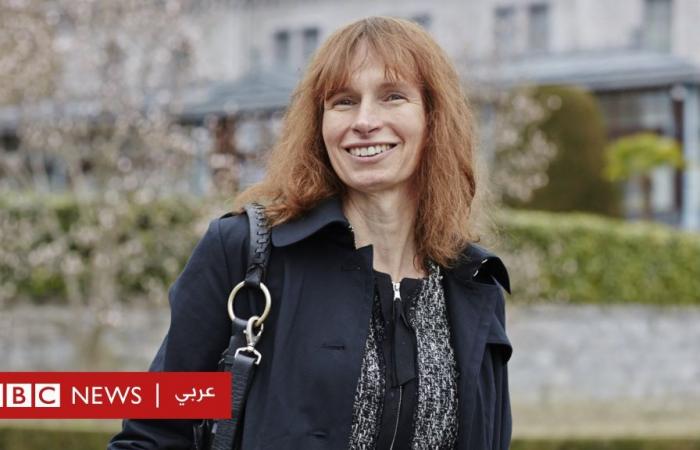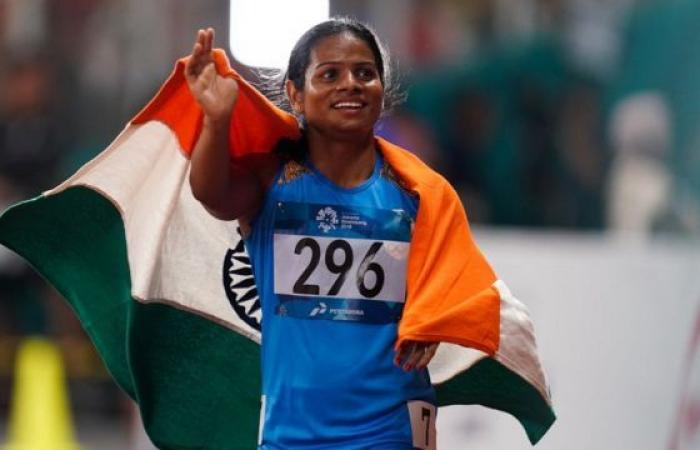- Megan Mohan
- BBC Gender and Identity Correspondent
4 hours ago

picture released, Getty Images
Joanna Harper, advisor to the International Olympic Committee and long-distance runner
It’s possible to make sport fair for everyone, says Joanna Harper, a long-distance runner and researcher who advises the International Olympic Committee on transgender athletes.
This story began over half a century ago, when a 6-year-old who lived in a small town in Canada asked his friend if he wished he could experience life as a girl.
His friend’s sarcastic and shocked reaction was enough that the child would not ask anyone else such a question again.
It was in the 1960s that Joanna Harper was born in a male body and named after her father.
Joanna felt at a young age that her gender identity was different; A girl in a boy’s body, the world to her was like a left-handed person living in a world designed for right-handed people.
She used to play with her sister’s toys and was drawn to women’s fashion, otherwise, she couldn’t express her thoughts.
But after all, it was the ’60s, who would have been able to advise Joanna about gender identity? Especially in the small town of Barry Sound where she lived, which was about 150 kilometers from northern Ontario in Canada.
So Joanna kept those thoughts to herself and occupied herself with the naturally occurring sport of running, running twice a day.
Athletic by nature
Her father was the head of the physical education department at the local high school, and by the time she reached her teens, Joanna was better at running long distances than him, and also excelled academically, particularly in the sciences.
By the time she graduated from high school, she was the best runner in the area.
Upon entering the university’s Faculty of Science, she joined a team that includes members from all over the country.
By the time she reached her mid-twenties, she was among the top 20 nationwide female distance runners in Canada.
True, sport gave Joanna a chance to escape the thought of who she was at the time, but she knew she was transgender.
“I always knew I was a girl even though all those years I lived as a boy,” she says.
After graduation, Joanna began working as a research scientist at a large medical facility in the United States.
Transgender
Joanna didn’t start taking hormone therapy until 2004, when she was in her forties, after the death of her father and sister, to begin her physical transformation from boy to girl.
Within weeks, she felt noticeably slower than before, and by the nine months of her treatment, her speed was 12 percent slower than before.
According to a study by RunRepeat, men run marathons 11 percent faster than women.

picture released, Mark Kolbe / Getty
Caster Semenya (center) and Margaret Wamboy (left) say they were punished for having naturally high testosterone levels
“I simply thought that meant I would be accepted into the women’s long-distance sprint,” Joanna says.
But this was not normally the case. Although there were very few in the running community talking about Joanna in her face, the whispers eventually came to her ear.
Many women felt that Joanna still had an unfair advantage due to her previous androgenic physiology.
At about the same time, discussions about transgender people in elite sport turned out to be the norm.
By 2005, both the International Olympic Committee and the USA Track and Field Administration announced that they would allow transgender athletes to compete on the basis of their specific gender after surgery and two years after receiving hormone therapy.
“Intellectually, it got me as a scientist,” Joanna says. “I wanted to analyze the performance of transgender athletes.”
the study
Although she did not major in sports science at that point, Joanna used her academic background in medical physics to collect data.
She began researching male-to-female trans athletes, and was eventually able to collect performance data for eight runners, both before and after the gender-based transition.
In 2015, Joanna published the first expert-reviewed study of transgender athletes that found that transgender women who were receiving hormone therapy to reduce testosterone levels showed no advantage over female-born female long-distance athletes.

picture released, Getty Images
Indian runner Dhoti Chand, who also has high testosterone levels like Semenya, was allowed to compete in the Tokyo Olympics.
Some criticized the study’s sample size, arguing that 8 people was too small for any meaningful result to be based, but others, such as geneticist Eric Phelan, described it as “pioneering”.
Joanna expanded her studies to become a biographical book in the field of sports for both sexes.
In 2019, she began her PhD studies in the School of Sports, Exercise and Health Sciences at Loughborough University for transgender athletes in the UK.
Her latest study, published in the British Journal of Sports Medicine, revealed that levels of hemoglobin (the protein that transports oxygen from the lungs to various parts of the body) in transgender women reach levels in line with biologically born women about four months after taking the hormone therapy.
However, her paper also concluded that the muscle and fat body mass of trans women are higher than their levels in women biologically born as a female after at least 36 months of receiving hormone therapy.
women’s sports
“I am a supporter of protecting women’s sports,” says Joanna. “If you go back a hundred years, you will see that the rise of women’s sports was one of the most important components of women’s march towards equality with men.”
She adds that the IOC included only women in 1928 in Amsterdam, and even then, it was only on five occasions. “Thus, women’s sports need sponsorship and that means there are eligibility requirements for admission.”
Today, conversations about the eligibility of transgender people in sports are emotionally charged.
In 2018, Rachel McKinnon, a transgender cyclist, said she received more than 100,000 hate messages on Twitter after winning the women’s tag team pursuit in the Track Cycling Championships.
The choice of New Zealander, Laurel Hubbard, as the first transgender athlete to compete in this year’s Tokyo Olympics, was a controversial decision.

picture released, Dan Mullan / Getty
Weightlifter Laurel Hubbard, the first-ever transgender athlete to compete in the 2020 Tokyo Olympics
Belgian weightlifter Anna Vanbellingen expressed her opinion on what happened to Laurel Hubbard in May, saying: “Anyone who has trained in weightlifting at a high level knows that this is true, this particular situation is not fair neither for athletes nor for sports.”
“Life-changing opportunities for some athletes, medals and Olympic qualifications, are lost, and we are powerless.”
But Joanna says she thinks Hubbard doesn’t have a unique advantage because weightlifting falls into weight classes. This means that athletes divide and compete in the subdivisions defined by their body mass.
“But we’re just at the beginning of these studies,” she continues. “In fact, it would take us about 20 years to get accurate data on transgender women in elite sport.”
In 2019, Joanna advised the International Olympic Committee on how this could work in the future. The results will be published after this year’s Tokyo Olympics.
Eligibility for admission
“There should be an appropriate eligibility requirement for every sport,” says Joanna. “Men’s minimum testosterone level is still four times higher than women’s. Eligibility must include a biomarker or biomarkers to separate the athletes.”
She suggests that testosterone levels be a vital indicator.
“Instead of dividing into male and female binary categories, there can be a gap in the level of testosterone (high or low levels of the hormone).”
In theory, this would include intersex athletes, such as South African middle-distance runner Caster Semenya, who had naturally elevated testosterone levels. In 2018, Semenya was banned from competing in the Olympics after world athletics ruled that “to ensure fair competition, women with high levels of natural testosterone should take medication to reduce its levels while running middle-distance races”.
This year, Namibian track and field stars Christine Mboma and Beatrice Maselenge were banned from competing in the women’s 400m at the Tokyo Games, due to their naturally high testosterone levels.
However, the current rules are narrow and limited, and only apply to athletes competing at middle distances (400m, 800m, and 1500m).
This means that an Indian runner who also has high testosterone levels like Semenya, is allowed to run the 100m at the Tokyo Olympics.
“But I realize that the category of women is very important to a lot of women,” adds Joanna.
“It would be ideal if we could find a way to integrate transgender athletes into women’s sports in a way that is fair for all.”
These were the details of the news Tokyo Olympics: “I’m a transgender athlete and I want to protect... for this day. We hope that we have succeeded by giving you the full details and information. To follow all our news, you can subscribe to the alerts system or to one of our different systems to provide you with all that is new.
It is also worth noting that the original news has been published and is available at eg24.news and the editorial team at AlKhaleej Today has confirmed it and it has been modified, and it may have been completely transferred or quoted from it and you can read and follow this news from its main source.





